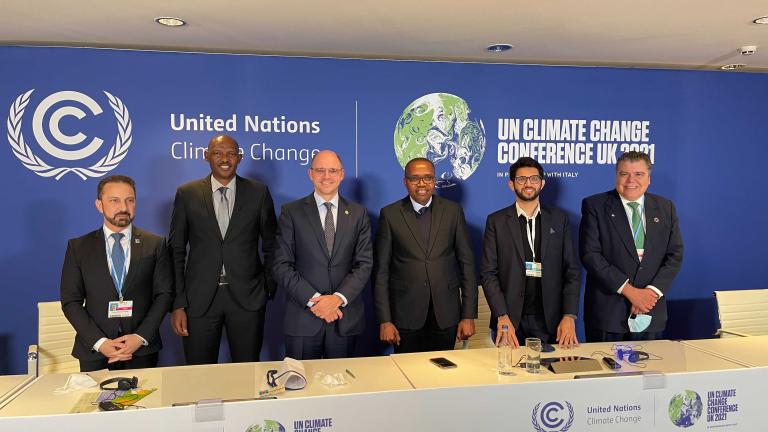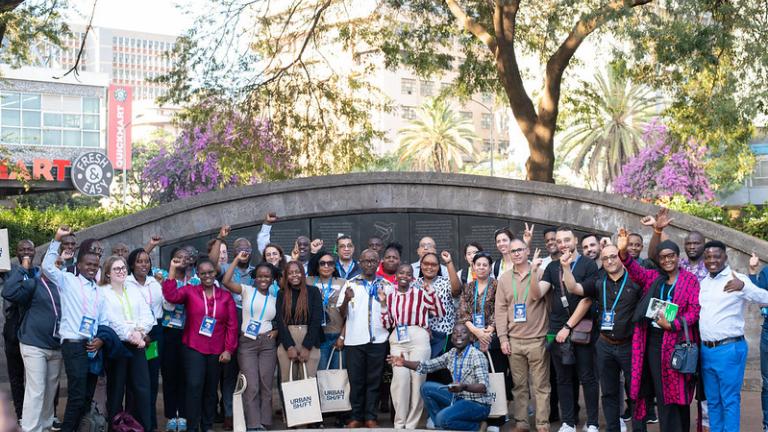Analysis
Where Do We Stand on COP26 Climate Promises? A Progress Report
As the world prepares for the next UN climate summit in November 2022 (COP27), where do we stand on the flurry of climate commitments made just one year ago?
Nico Smit / Unsplash
Leaders left the climate summit in Glasgow (COP26) in November 2021 riding high on a wave of new commitments from governments, businesses and others to tackle the climate crisis. This included pledges to set new national emission-reductions targets, double adaptation finance, curb methane emissions, halt forest loss, accelerate the phase-out of coal, and end international financing for fossil fuels, just to name a few.
In the months since, things are less rosy. Russia’s war on Ukraine and rapid inflation have caused global energy and food prices to soar, distracting leaders from climate action. The ongoing COVID-19 pandemic and tensions between China and the United States over Taiwan haven’t helped. "Climate action is being put on the back burner — despite overwhelming public support around the world," stated UN Secretary-General António Guterres on the sidelines of the UN General Assembly meetings in September 2022.
As the world prepares for the next UN climate summit in November 2022 (COP27), where do we stand on the flurry of climate commitments made just one year ago?
Here, we track the progress.
National Climate Commitments
What was promised?
At COP26, countries agreed to revisit and strengthen their 2030 emissions-reduction targets “as necessary” to align with the Paris Agreement’s goal of limiting warming to 1.5 degrees C (2.7 degrees F). Sticking to this level of temperature rise is essential for averting some of the worst impacts of climate change.
Where we stand
Since Glasgow, 24 of 194 countries that are party to the Paris Agreement have come forward with new or updated emissions-reduction targets (known as “nationally determined contributions,” or NDCs).
The good news: Under a new administration, Australia bumped its pledge into credible territory after its woefully inadequate 2015 target to slash emissions 26-28% below 2005 levels by 2030. The country now aims to cut emissions by 43% by 2030. Vanuatu submitted a particularly inspiring plan that aims to phase out fossil fuels, invest in electric vehicles, and undertake a number of detailed measures to address loss and damage. Ahead of COP26, the United Kingdom put forward an ambitious target to cut emissions 68% below 2010 levels by 2030. The U.K.’s latest revision offers greater clarity on the policies to get there, such as investing in clean energy and ending the sale of petrol and diesel vehicles by 2030. However, in September 2022, the UK government had a change of leadership and some of its climate policies are currently under review.
Indonesia slightly improved its top-line goal to cut emissions from 29%- to 31.89% by 2030 compared to business as usual. The nation will increase this target to 43.2% on the condition it receives enough financial assistance. India’s plan includes a target to reduce the emissions intensity of its GDP by 45% and achieve 50% renewable energy capacity by 2030; it also reiterated the country’s pledge to reach net-zero emissions by 2070.
Most disappointingly, Brazil’s revised plan failed to strengthen its emissions cuts compared to what it put forward in 2016.
Chile, Mexico, Turkey and Vietnam are expected to submit stronger plans ahead of COP27. European Union officials hope to strengthen its emissions-reduction target, too, but not in time for COP27. The United States hasn’t indicated whether it will put forward an updated plan ahead of COP27, but recently passed the historic Inflation Reduction Act, which contains major climate and clean energy provisions that will put its 2030 emission-reductions target within reach.
China, the world’s largest source of greenhouse gas emissions, hasn’t hinted whether it will strengthen its targets.
Ramping Up Renewables and Phasing Out Fossil Fuels
What was promised?
The final COP26 agreement emphasized urgency in scaling up clean power, phasing down coal and phasing out fossil fuel subsidies. A group of 46 countries — including the U.K., Canada, Poland and Vietnam — committed to phase out unabated domestic coal, while an additional 39 countries committed to end new overseas finance of fossil fuels by the end of 2022 and redirect this investment to clean energy.
Where we stand
Renewable energy installations reached new heights in 2021 — totaling 295 gigawatts (GW) of green generating capacity — and the International Energy Agency expects these to rise 8% further by the end of this year, even though raw materials costs recently increased 15-25%. China still leads the pack in clean energy installations, but the United States may soon pick up its pace thanks to incentives for wind and solar in the Inflation Reduction Act. Europe’s renewable electricity continued to expand, with average annual growth of 44 TWh in the last two years. And in September 2022, Denmark and trade associations launched a new effort to boost offshore wind capacity by 670%, from 57 GW today to 380 GW by 2030.
At the same time, Russia’s invasion of Ukraine has made some countries focus more on shoring up fossil-based energy supplies as they grapple with near-term energy shortages and rising costs. Due to the sudden stop in Russian gas supply and energy demand in the winter, numerous European countries have reopened or extended coal-fired power plants and are ramping up natural gas deliveries from Norway, the U.S., and countries in North Africa, Middle East and Asia — even as they insist this shift is temporary and that the bloc’s 2030 climate targets will be met. One estimate finds European governments will spend tens of billions of dollars this winter on expanding fossil fuel infrastructure and supplies while simultaneously taking unprecedented steps in reducing energy consumption and speeding up renewables.
Additionally, China approved new coal mines and Australia is poised to do the same, while Vietnam and Indonesia seek to boost coal production and the United Kingdom announced new North Sea oil and gas licenses.
A recent report by the OECD found that global subsidies for fossil fuels almost doubled in 2021 from 2020 levels and are estimated to increase even further due to mounting fuel prices. While G7 leaders recently reaffirmed their commitment to end international finance for fossil fuels, they made an exception for natural gas finance during the current energy crisis.
Climate Finance
What was promised?
In 2009, rich nations committed to mobilize $100 billion a year from 2020-2025 to support climate action in developing countries. At COP26, it became clear that developed countries failed to meet that goal in 2020, though they are still on the hook to deliver it.
Countries also agreed to at least double funding for adaptation by 2025 from 2019 levels, to around $40 billion per year. Meanwhile, more than 70 organizations, including eight countries, endorsed a set of principles to ensure local communities have equitable access to climate adaptation finance and decision-making, and $450 million was committed to locally led adaptation programs.
South Africa announced with France, Germany, the United Kingdom, the United States and the European Union an historic Just Energy Transition Partnership. The developed countries participating said that they would mobilize $8.5 billion over the next 3-5 years to support a just transition toward a low-emissions, climate-resilient economy in South Africa.
Where we stand
An OECD report published in July 2022 reveals that in 2020, developed countries were still $17 billion short of the $100 billion annual finance goal. While most climate finance in 2020 was directed to curbing emissions (as in previous years), finance for adaptation accounted for a third of the total, or $28.6 billion. More funding is needed to fulfill the $100 billion commitment now, as well as the pledge to reach $40 billion of adaptation finance in future years.
By September 2022, the number of organizations endorsing the “Principles for Locally Led Adaptation” had swelled to 80, and some are integrating these commitments into their policies. For example, USAID is expanding investments to organizations prioritizing locally led approaches and aims to up its target from directing 25% of its funding to projects that “place local communities in the lead” to 50%.
Since COP26, the South African government has worked to define priority interventions for its Just Energy Transition Partnership and engage with relevant domestic stakeholders and donor countries. South African government officials are currently developing an investment plan to support workers that will be most impacted in the clean energy transition ahead, with a specific focus on the power, electric vehicles and green hydrogen sectors. The investment plan is anticipated to be released at COP27, following approval by South Africa’s Cabinet and the donor countries.
Following the G7 summit earlier this year, G7 leaders also announced they would work on new just energy transition partnerships with India, Indonesia, Vietnam and Senegal to help phase out coal and fund their transition toward clean energy. No details, including the amount of support for each country, have been announced yet.
Reaching Net-zero Emissions
What was promised
By the end of COP26, 74 countries promised to reach net-zero emissions by mid-century. More than 600 companies also set net-zero emissions targets in the run-up to COP26. The Science Based Targets initiative launched a Net-zero Standard to ensure these targets were rigorous and aligned with the latest climate science.
Where we stand
Since COP26, seven additional countries committed to reach net-zero emissions, including Indonesia and South Africa, which intend to reach net-zero by midcentury. All G20 countries, except Mexico, now have a net-zero target.
Countries such as Australia and Chile have also backed up their previous net-zero targets by passing national legislation that mandates they net-zero emissions by 2050.
With so many net-zero targets now set, nations must start taking near-term actions that will make reaching their net-zero ambitions possible. Some countries are doing just that. For example, Canada released its Emissions Reduction Plan, Nigeria launched its Energy Transition Plan, and the EU is revising its climate, energy and transport-related legislation under the “Fit for 55 package” in order to align current laws with its 2050 carbon neutrality goal.
On the corporate side, nearly 1,400 companies had committed to net-zero emissions as of September 2022, including 780 of the 2,000 largest publicly traded companies. Relatedly, Norway’s sovereign wealth fund now requires net-zero targets from the companies in which it invests.
Greening the Financial Sector
What was promised?
The Glasgow Financial Alliance for Net Zero (GFANZ) was formed in April 2021 to push the financial sector to reach net-zero emissions by mid-century. By COP26, the initiative included more than 450 financial firms with $130 trillion in assets under management. As the Taskforce on Climate-related Disclosures (TCFD) Framework increasingly becomes the financial industry’s norm for climate-related disclosures, GFANZ has pushed the sector to set actionable net-zero transition plans, including interim science-based targets and transparency on progress.
Where we stand:
GFANZ has since grown to more than 500 members. In 2022, it launched regional networks to support financial institutions’ shift to net-zero and issued guidance on crafting credible net-zero transition plans and measuring net-zero portfolio alignment. In September 2022, GFANZ leadership issued a statement urging for deforestation to be incorporated into institutions’ net-zero planning.
Since COP26, some financial institutions have acted on their net-zero commitments, such as HSBC and Bank of America, which published their first net-zero targets. Because of the varying quality and ambition of these targets, it remains to be seen if they will translate into real-world emissions reductions and transition away from fossil fuel financing. Increasing numbers of financial institutions have had their net-zero targets validated through initiatives like the Science-Based Targets initiative, lending credibility to their commitments.
Despite that progress, GFANZ has faced headwinds. In September 2022, it came to light that two pension funds, Bundespensionskasse AG of Austria and CBUS of Australia, exited the alliance because they felt new requirements were too stringent. Several of the largest U.S. banks have also reportedly threatened to withdraw from GFANZ over concerns the standards open them up to legal risk in the United States. These developments, in addition to growing political attacks on environmental, social and corporate governance (ESG), raise alarms that financial institutions may backtrack on their net-zero commitments.
Curbing Methane
What was promised?
At COP26, 103 countries signed up to the Global Methane Pledge to collectively reduce methane emissions 30% below 2020 levels by 2030. Methane is a powerful greenhouse gas, with a global warming potential 86 times that of carbon dioxide over a 20-year period. The U.S. and China also signed a joint declaration in Glasgow to enhance methane emissions controls, including by developing methane action plans.
Where we stand
Since COP26, 19 additional countries formally endorsed the Global Methane Pledge. Signatories now collectively represent over three-quarters of the global economy and half of global methane emissions.
In June 2022 at the Major Economies Forum, the U.S. and E.U. launched the Global Methane Pledge Energy pathway — a joint initiative to reduce methane emissions from the energy sector — as a critical step in implementing the Global Methane Pledge. This effort includes $59 million in funds and in-kind assistance from the U.S., E.U., Germany, Norway, Canada, UNEP and other philanthropic organizations to support additional R&D, policy development, and enforcement and implementation to cut methane emissions from the oil and gas sector.
Curbing methane emissions was one of the bright spots for U.S.-China collaboration at COP26, but since then, tensions between the two countries over Taiwan led China to suspend climate cooperation. U.S. and Chinese top diplomats did shake hands on the sidelines of the U.N. General Assembly meeting in September 2022, renewing hope that the world’s two largest emitters may rekindle their joint efforts to tackle climate change.
Halting Deforestation
What was promised?
Under the Glasgow Leaders Declaration on Forests and Land Use, more than 140 countries pledged at COP26 to halt and reverse deforestation and land degradation by 2030. A group of the largest agricultural commodity companies agreed to release at COP27 a shared roadmap for enhanced supply chain action consistent with a pathway to limit warming to 1.5 degrees C (2.7 degrees F). Group of 12 governments pledged to provide $12 billion for forest-related climate finance between 2021-2025, and a coalition of public sector donors and private philanthropies pledged an additional $1.7 billion to support Indigenous Peoples and local communities. And more than 30 financial institutions committed to create individual organizational plans, milestones and incentives for commitments on deforestation-free agricultural commodity portfolios.
Where we stand:
Since COP26, four new countries joined the Glasgow Leaders’ Declaration on Forests and Land Use: The Holy See, Nicaragua, Singapore and Turkmenistan. This brings the total signatories to 145. G20 countries notably absent include India, Saudi Arabia and South Africa.
The Forests and Climate Leaders’ Partnership (FCLP) will launch at COP27 to accelerate implementation of the Glasgow Leaders’ Declaration through country-led commitments, increased ambition over time and annual meetings to take stock of progress. The FCLP will build on existing commitments focusing on sustainable land use enterprises, supporting Indigenous Peoples and local communities and mobilizing public and private finance.
The agricultural commodity traders’ Roadmap of Action has been developed throughout 2022 and is expected to be released ahead of COP27. The 12 governments that pledged $12 billion at COP26 are expected to report on their progress at COP27. By the end of 2022, the 30 financial institutions are expected to assess their exposure to deforestation risk through financing or investment in clients/holdings, as well as establish policies and engagement strategies to address this exposure. In September 2022, the group published a document outlining investor expectations of companies.
Greening Cities
What was promised?
At COP26, more than 1,000 cities and local governments, representing a quarter of global emissions, joined the Cities Race to Zero, pledging to reach net-zero emissions in the 2040s or sooner.
Where we stand:
As of September 2022, 1,136 cities had signed up to Cities Race to Zero. This is a significant milestone that should serve as a catalyst for further pledges across multiple sectors.
The recently published Race to Zero report, however, provides little data on progress. It notes that only one-third of cities that have been members of the initiative for more than one year are reporting on progress; of those, 84% are taking action. Furthermore, data on targets and, critically, actual emissions reductions is unfortunately lacking.
Increased accountability is critical to the success of Cities Race to Zero, as is the ability of city leaders to persuade national governments to help advance their ambitions via funding; linking city, regional and national strategies; and creating enabling fiscal and regulatory environments. This needs to be a stronger focus of the Race to Zero campaign going forward, alongside ensuring that resource-constrained cities — particularly those in the Global South — can access to the necessary data, capacity-building and technical assistance to translate pledges into action.
Electric Vehicles
What was promised?
More than 100 countries, cities, states and major businesses signed a declaration to end the sale of internal combustion engines in leading markets by 2035 and worldwide by 2040.
Where we stand:
According to the International Council on Clean Transportation, as of June 2022, 18 countries and states had committed to phase out internal combustion light-duty vehicles between 2030 and 2050; nine committed to some level of phase-out for internal combustion trucks; and 11 committed to zero-emission buses. Other cities, states and countries have memorandums of understanding in the works.
Some manufacturers have announced electric vehicle sales percentage targets, particularly in Europe, where more than a dozen car companies say they will be selling 100% battery electric vehicles within the next 10 years.
The United States, the single-largest contributor to global transport emissions, recently passed major legislation that created the biggest federal commitment to zero-emission vehicles and infrastructure yet. The Inflation Reduction Act offers Americans tax credits to purchase new and used electric vehicles as well as $1 billion to electrify medium- and heavy-duty vehicles. In addition, the Infrastructure Investment and Jobs Act provides $7.5 billion to create an electric vehicle charging network and $5 billion each for zero- and low-emission school buses and low- and no-emission transit buses.
What’s Needed at COP27 and Beyond?
Progress made on COP26 commitments since Glasgow is mixed at best. But to be fair, countries and others often save up their exciting announcements for major international moments. Hopefully we are in for some nice surprises when world leaders gather in Sharm el-Sheikh, Egypt for COP27. The world will be watching carefully to see if countries, companies and cities back up their commitments with real action.
READ MORE

UrbanShift at COP27
UrbanShift led and participated in crucial discussions around climate finance, multi-level governance, and nature-based approaches in Sharm el-Sheikh, providing our stakeholders with a space to share their climate goals and challenges.

COP26: Transforming cities through multi-level governance
At UrbanShift's COP26 side event, we highlight examples of multi-level governance and climate action from Brazil, Rwanda and India.

5 Priorities for Cities After COP26
Now that the dust has settled from Glasgow, what does COP26 mean for cities? As we reflect on the outcomes, five priorities stand out for cities and national governments to focus on.

How African cities can develop to become green, resilient, and inclusive
During the Green & Resilient UrbanShift Africa Forum, leaders from across the continent united to learn and share insights on accelerating transformative urban planning approaches—and the finance needed to implement them.

